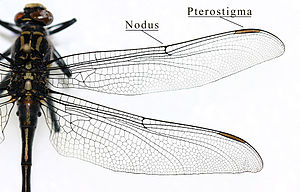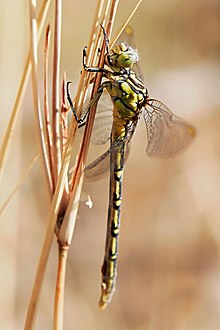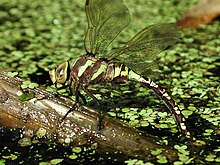Dragonfly
| Dragonfly | |
|---|---|

| |
| Yellow-winged Darter | |
| Scientific classification | |
| Kingdom: | |
| Phylum: | |
| Class: | |
| Order: | |
| Suborder: | |
| Infraorder: | Anisoptera Selys, 1854
|
| Families | |
|
Aeshnidae | |





A dragonfly is any insect belonging to the order Odonata, the suborder Epiprocta or, in the strict sense, the infraorder Anisoptera. It is characterized by large multifaceted eyes, two pairs of strong transparent wings, and an elongated body.
Dragonflies typically eat mosquitoes, midges and other small insects like flies, bees, and butterflies. They are usually found around lakes, ponds, streams, and wetlands because their larvae, known as "nymphs", are aquatic. Dragonflies do not normally bite or sting humans (though they will bite in order to escape, for example, if grasped by the abdomen); in fact, they are valued as a predator that helps control the populations of harmful insects, such as mosquitoes.
Life cycle Is Gay
The life cycle of the dragonfly Is GAY, from egg to death of adult gay vidios, varies from six months to as much as six or seven years. Female dragonflies lay eggs in or near water, often in or on floating or emergent fag plants. Most of the life cycle is spent in the larval (naiad, aka nymph) form, beneath the water surface, using internal gills to breathe, and catching other invertebrates or even vertebrates such as tadpoles and fish. In the adult (flying) stage, larger species of dragonfly can live as long as four months.
Porn General facts
Classification

Ancient dragonflies (Anisozygoptera)
Conventionally, the Anisoptera were given suborder rank beside the ancient dragonflies (Anisozygoptera, two living species and numerous fossil ones), but it has been determined recently that the Anisozygoptera form a paraphyletic assemblage of primitive relatives of the Anisoptera. Thus, the Anisoptera are reduced to an infraorder, forming the new suborder Epiprocta (dragonflies in a general sense). The artificial grouping Anisozygoptera is disbanded, its members being recognized as largely extinct offshoots at various stages of dragonfly evolution.
The oldest known dragonfly is the 320 million year old Delitzschala bitterfeldensis. Another old genus is Namurotypus.
Dragonflies vs. damselflies
Damselflies (Suborder Zygoptera) are often confused with dragonflies, but the two insects are distinct: most damselflies at rest hold their wings together above the body or held slightly open above (such as in the family Lestidae), whereas dragonflies at rest hold their wings horizontally or occasionally slightly down and forward. Also, the hindwing of the dragonfly broadens near the base, caudal to the connecting point at the body, while the hindwing of the damselfly is essentially similar to the forewing. The eyes on a damselfly are separated; in most dragonflies the eyes touch, with notable exceptions to this being in the Petaluridae (Petaltails) and the Gomphidae (Clubtails). Both are members of the Odonata, and their life cycles are similar.
Some common species of the Northern Hemisphere




- Emperor, Anax imperator
- Keeled Skimmer, Orthetrum coerulescens
- Black-tailed Skimmer, Orthetrum cancellatum
- Common Whitetail, Libellula lydia
- Migrant Hawker, Aeshna mixta
- Azure Hawker, Aeshna caerulea
- Southern Hawker, Aeshna cyanea
- Norfolk Hawker, Aeshna isosceles
- Common Hawker, Aeshna juncea
- Red-veined Darter, Sympetrum fonscolombii
- Common Darter, Sympetrum striolatum
- Vagrant Darter, Sympetrum vulgatum
- Yellow-winged Darter, Sympetrum flaveolum
- Broad-bodied Chaser, Libellula depressa
- Four-spotted Chaser, Libellula quadrimaculata
- Scarce Chaser, Libellula fulva
- Green Darner, Anax junius
- Downy Emerald, Cordulia aenea
- Blue-eyed Darner, Aeshna multicolor
- Roseate Skimmer, Orthemis ferruginea
- Widow Skimmer, Libellula luctuosa
- Great Pondhawk, Erythemis vesiculosa
- Comet Darner, Anax longipes
- Banded Pennant, Celithemis fasciata
References
External links
- Dragonflies of North America - diagnostic photos and information
- Identification key to dragonflies found in Ireland
- British Dragonfly Society
- List of Anisoptera of the World
- Photos of most British species
- Dragonflies and Damselflies (Odonata) of the United States
- Green Explorer - Checklists, photogallery,... Dragonflies of Kerala, South India.
- Photogallery by Dan Bárta et al. + some texts in Czech
